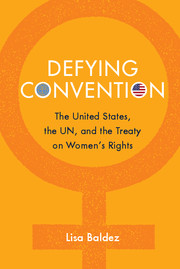Book contents
- Frontmatter
- Dedication
- Contents
- Acknowledgments
- 1 Introduction
- 2 A Scaffolding for Global Women’s Rights, 1945–1970
- 3 Geopolitics and Drafting the UN Treaty on Women’s Rights
- 4 An Evolving Global Norm of Women’s Rights
- 5 CEDAW Impact: Process, Not Policy
- 6 Why the United States Has Not Ratified CEDAW
- 7 CEDAW and Domestic Violence Law in the United States
- 8 Conclusion
- Works Cited
- Index
4 - An Evolving Global Norm of Women’s Rights
Published online by Cambridge University Press: 05 August 2014
- Frontmatter
- Dedication
- Contents
- Acknowledgments
- 1 Introduction
- 2 A Scaffolding for Global Women’s Rights, 1945–1970
- 3 Geopolitics and Drafting the UN Treaty on Women’s Rights
- 4 An Evolving Global Norm of Women’s Rights
- 5 CEDAW Impact: Process, Not Policy
- 6 Why the United States Has Not Ratified CEDAW
- 7 CEDAW and Domestic Violence Law in the United States
- 8 Conclusion
- Works Cited
- Index
Summary
Members of the UN have signed scores of statements, platforms, declarations, and resolutions that articulate a commitment to women’s rights. Among them are the Beijing Platform for Action, which outlines “an agenda for women’s empowerment” (UN Women 1995); UN Security Council Resolution 1325, which “urges” and “calls upon” countries to incorporate women and women’s needs into conflict resolution (Office of the Special Adviser on Gender 2000); and the Declaration on the Elimination of Violence against Women, which “urges that every effort be made” to address domestic and sexual violence (United Nations 1993). What sets CEDAW apart from other international agreements on women’s rights is that CEDAW has the force of international law. Ratification of CEDAW legally obligates countries to take “all appropriate measures” to eliminate discrimination against women.
Today CEDAW is one of the most important instruments for advancing women’s rights in the international arena, but it did not start out that way. Although the formal text of CEDAW has not changed since the General Assembly adopted it in 1979, its meaning has evolved over time in terms of how it is interpreted, implemented, and supported. In the thirty years since it came into force, CEDAW has grown in global visibility, relevance, and influence. It has gained prominence within the UN system, within the countries that have ratified it, and among activists in the transnational women’s movement. Several factors have strengthened CEDAW. Over time, the Committee that oversees the Convention has developed an increasingly clear interpretation of what constitutes discrimination against women, has become more effective in administering the treaty, and has greater legitimacy, as demonstrated by a growing number of domestic laws and judicial decisions that refer to CEDAW directly. Second, political considerations no longer trump women’s rights in the way that governments and Committee experts interpret the treaty. Changes in the global balance of power, particularly the end of the Cold War, have reduced the degree to which ideological conflicts between the U.S. and the Soviet Union eclipse a focus on women’s issues per se within the CEDAW Committee and in government reports. Politics continue to permeate the CEDAW process, but the nature of the political conflicts has changed.
- Type
- Chapter
- Information
- Defying ConventionUS Resistance to the UN Treaty on Women's Rights, pp. 100 - 129Publisher: Cambridge University PressPrint publication year: 2014



